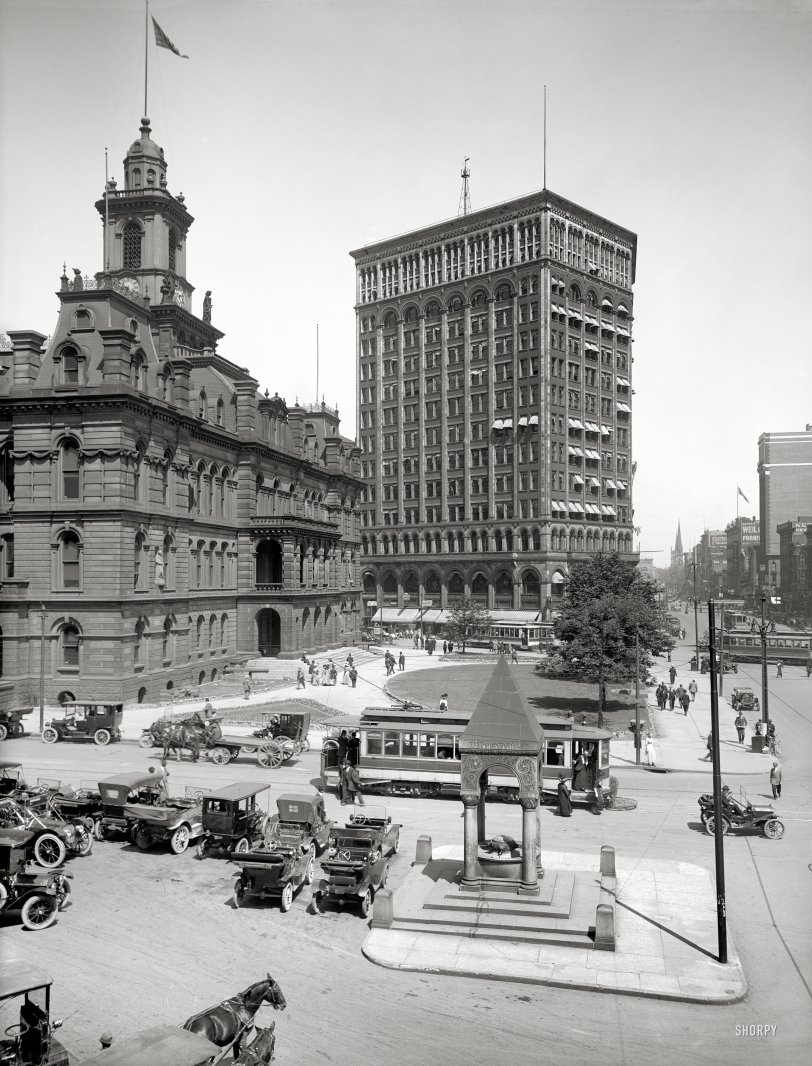


Framed or unframed, desk size to sofa size, printed by us in Arizona and Alabama since 2007. Explore now.
Shorpy is funded by you. Patreon contributors get an ad-free experience.
Learn more.

- Roll your own
- Rugged and real!
- A Charles Purcell - Mama Cass Connection
- Uncle SAAM
- Obfuscation
- One Chocolate Soldier rode away
- Victor Marquis de la Roche
- The Little House Across Way ...
- Vanderbilt Gates
- Vanderbilt Mansion
- You can still see that gate
- Withering heights for me
- So Jim,
- Top Heavy
- Re: Can't Place It.
- Bus ID
- Since you mention it
- The White Pages ?
- Moonlight Tower
- 1907?
- Fire(men) and Water
- Can't Place It
- Can anyone
- Wings
- Where's Claudette and Clark?
- Overbuilt Rolodex
- One song
- Give Me Wings Please!
- PRR
- Pinball Wizards
Printporium
Bustling Detroit: 1912

The Motor City circa 1912. "Campus Martius. Detroit City Hall, Bagley Fountain and Majestic Building." Detroit Publishing glass negative. View full size.
Gone, gone, gone
Can you imagine that when the Old City Hall was demolished in the 1960s, they considered it progress?
Car-mounted catcher
I just came across this picture last night, of this cow catcher touted for autos.
https://www.shorpy.com/node/4468
Hanging On
Yes, you, the guy standing in the window in the Majestic Building.

Watch Out For The Cows!
tterrace's comment had me going to Google to see what these contraptions were called when fitted to streetcars. Apparently the proper terminology was "streetcar fender". There were an abundance of patents issued for designs to enhance the safety of pedestrians who were reckless enough to walk in front of moving streetcars. Some required the conductor to pull a cord to lower the fender when a collision was eminent, while others were designed to be deployed full time on the forward facing end of the streetcar.

Streetcar catcher contraption?
Looks like the the thing on the front of the streetcar was designed to provide a humane landing zone rather than just plowing cows/horses out of the way.
[That's a cowcatcher. - tterrace]
Horsedrawn
When I was a child, in the early '50's, they were still delivering milk with horses, at least in Flint, "The Auto City".
Watch your step!
Look at the drop from the front of that streetcar step to the pavement, yikes! Don't know how women managed with those long cumbersome dresses. It's good the miniskirt came along - strictly for the comfort of the ladies of course, naturally.
Bagley Fountain
The water fountain in the foreground was given to the citizens of Detroit by John Bagley; one of the founders of the Republican Party, staunch Abolitionist, City Councilman, Governor of Michigan and tobacconist.
Long before Detroit was the center of Automobile manufacturing, tobacco was a huge business with over 100 cigar and snuff factories in different parts of the city.
The Bagley Fountain was built for both humans and horses as I believe there is a horse trough on the side we can't see. It was moved to Cadillac Square in the 1920s (I believe). It is still there and was outfitted with new piping a couple years ago.
I can't say I've ever drunk from the fountain as it is mainly used by our wandering class of citizens for their morning ablutions. Personally I care to honor their territorial markings.
For more complete information, may I suggest:
http://historicdetroit.org/building/bagley-memorial-fountain/
This picture, on the right
This picture, on the right hand side, looks the opposite direction down Woodward Ave than the Eureka 1910 picture does. I'm surprised mostly by how many streetcars are running up and down Woodward. Not just one every hour or half hour, but dozens in a one block area.
Always a surprise
... to see how much the automobile changed both our lives, and the views of the city streets that these photos provide. When is the last time that Detroit saw horse-drawn deliveries? There are still enough horse-drawn carts for deliveries and vendors to make their appearance in 1933's "Duck Soup" seem plausible. Did Detroit, the city built on the automobile, get rid of their old-fashioned alternative sooner?
Zip!
I'm always a little impressed with how quickly modern America happened: stone-built cities rivalling Europe's, built up from bare ground in little more than a lifetime and packed with cars recognisably like our own only eight years after Oldsmobile introduced mass-produced cars.
And some of the people in this scene may have flown around the World on jet airliners.
Testamentary ?
/-'men-/ a. of or given in a person's will.
Yes, I had to look it up in the Oxford dictionary.
























On Shorpy:
Today’s Top 5